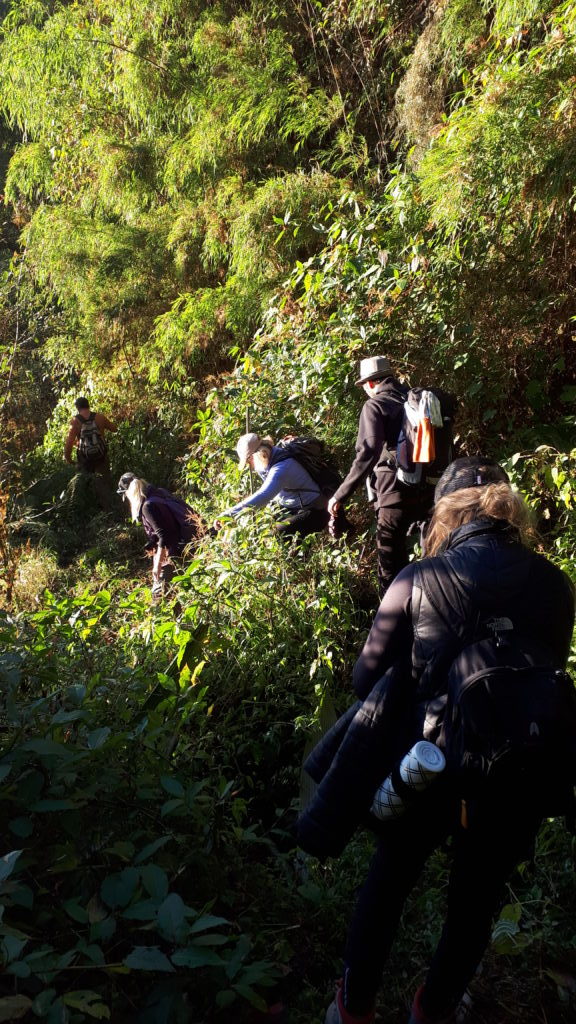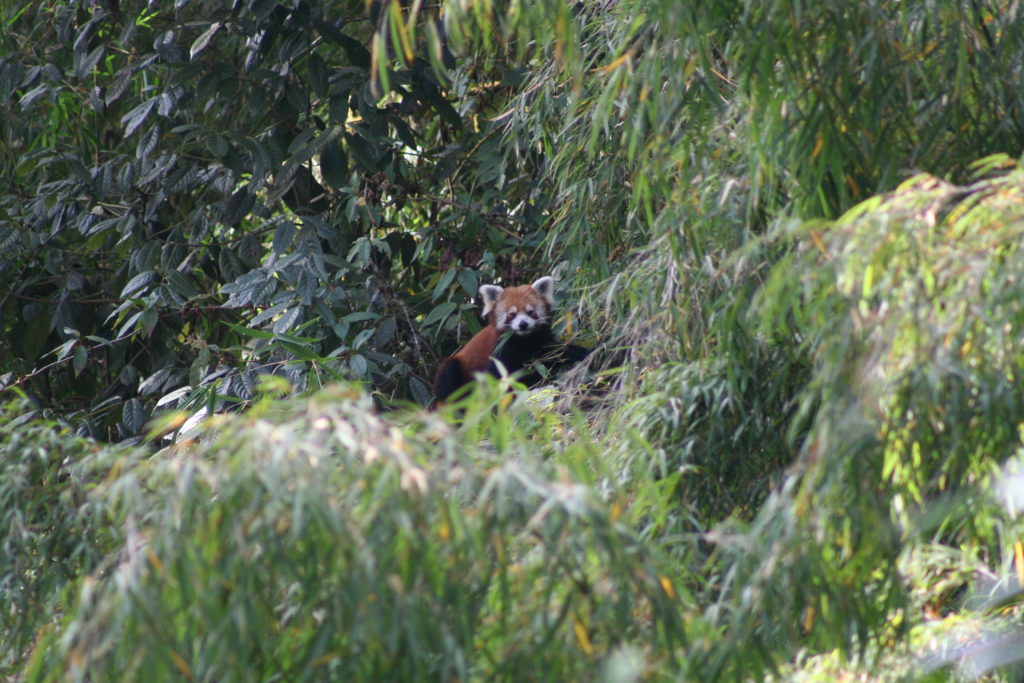
A GROUP OF EIGHT ECOTRIPPERS ARRIVED IN NEPAL TO SEE RED PANDAS IN THEIR NATIVE HABITAT. THEY SAW EIGHT DURING THE MOST SUCCESSFUL ECOTRIP IN RPN HISTORY.
It was late November when participants of Red Panda Network (RPN)’s 2018 Eco Zoo Trip arrived in the Himalayan hills of Eastern Nepal. The group—led by Sarah Jones and head red panda tracker, Phinju Sherpa, as well as local Forest Guardians (FGs)—included staff from Detroit Zoo, SeaWorld San Antonio and Longleat Safari Park. The weather was ideal as they began trekking through one of our planet's biodiversity hotspots.
 Hiking through bamboo forest. Photo by Sarah Jones.
Hiking through bamboo forest. Photo by Sarah Jones.
 Viewing PIT forest from hilltop. Photo by Sarah Jones.
Viewing PIT forest from hilltop. Photo by Sarah Jones.
Before their arrival in Kathmandu, many of the ecotrippers weren’t sure what to expect as far as encounters with wild red pandas. As employees of zoos who partner with conservation organizations like RPN, they were aware of the animal’s elusive nature and endangered status. Julie Washnock of SeaWorld San Antonio shares her pre-departure feelings:
“To me, this trip was a once in a lifetime experience in every sense of the word. I went into it with the thought that there is a large chance I won’t see a red panda. The species is endangered, and we can only cover a small amount of land hiking through their habitat. My goal was to immerse myself in Nepali culture, experience new things, and learn about the impacts RPN has made in the area.”
Within their first few hours of hiking, the group was led by FGs to a pair of red panda cubs.
“I will never forget or be able to accurately put my feelings into words about that first glimpse. We had climbed through dense forest to sit along a steep area in complete silence, just watching these sleepy cubs. It was so tranquil and such a perfect little moment in time. The entire group was smiling, snapping photos, gasping and giggling at every move the cubs made,” Washnock continued. “Little did we know the excitement had just started.”
Since 2011, RPN has been leading ecotrips in Ilam, Eastern Nepal. They have now expanded to the adjoining Taplejung district as well as locations in Central Nepal. Their success rate of red panda sightings during trips has been at 100% for over three years.
“After eating and the morning’s excitement, we rested for a bit. Napping on the hillside in the Himalayas: one of the most relaxing moments of my life. As some of us were drifting off and settling down in the afternoon sun for a short break, others were scanning the tree tops for a chance red panda sighting.”
Their guide, Sarah Jones, spotted another panda and the group watched it forage for lunch in the trees. They would see five more red pandas before the trip was over. In total, they viewed two pairs of red panda cubs and three individual pandas in Choyatar Community Forest and one individual in a national forest in Dobato of Mabu village.
 Red panda from afar. Photo by Sarah Jones.
Red panda from afar. Photo by Sarah Jones.
 Photo by Sarah Jones.
Photo by Sarah Jones.
“Everyone was so excited. We hoped to spot at least one or two red pandas during the trip but eight different sightings is unbelievable” said Phinju Sherpa, FG and head tracker who led the trip.
Dhan Bahadur Khamdak, Project Coordinator at RPN’s local partner, Mountain Organization Nepal (MOON) in Ilam, sees the eight sightings as an indicator of successful community-based conservation programs in the PIT corridor. Since 2012, MOON has been working with RPN, local government agencies and communities to raise red panda awareness and improve habitat.
“When we started our red panda conservation work, people had very little knowledge of this animal,” Khamdak said. According to him, during the initial years, red panda sightings were very rare. “Now, locals are aware and committed to saving red pandas and visitors are able to spot healthy red panda cubs during ecotrips.”
Ecotrips are important for both tourists and local people. Trip participants are able to experience, firsthand—and form a deep connection with—the incredible biodiversity of the Himalayas, as well as RPN’s community-based conservation work, while local communities benefit by providing homestay and nature guide services to ecotourists. This sustainable development model along with RPN’s low-impact approach to ecotourism helps to ensure the conservation of forests and enhancement in the local economy.
 2018 Eco Zoo Trippers with homestay owners and FGs. Photo: Sarah Jones.
2018 Eco Zoo Trippers with homestay owners and FGs. Photo: Sarah Jones.
 Clouds moving in over PIT corridor. Photo by Sarah Jones.
Clouds moving in over PIT corridor. Photo by Sarah Jones.
RPN strictly follows red panda tracking procedures that were developed by RPN and the Red Panda Conservation and Ecotourism Promotion Committee in Eastern Nepal in 2015. They include no trips during mating and birthing seasons, and not allowing repeated visits to a single red panda site. All tracking is done by trained RPN field staff and FGs who prioritize maintaining undisturbed and protected habitats.
Ang Phuri Sherpa, RPN’s Country Director in Nepal, found the eight sightings to be very encouraging: “Over the years, our efforts in Eastern Nepal have yielded some positive results,” Ang commented. “Locals are now aware of the importance of red pandas. For them, increased red panda sightings means more visitors and thus contributing to the sustainability of their livelihoods.”
After over two weeks of travel and trekking in the Himalayan hills, Julie Washnock shared Ang’s optimism, “To me, this was a complete affirmation that the efforts of the RPN have made a huge impact not only on the local people, but on the red panda population,”. She recalled speaking to a Nepali woman about the new cooking stoves RPN had provided her village. Because of this stove, she no longer needed to spend her days tending to their fire. She was now able to get outside to help her family with their garden. She said she felt so much healthier because she was able to get away from the smoke, and I’ll never forget the smile on her face.”
